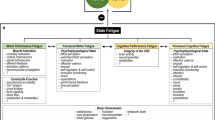Abstract
Introduction Continuous typing is likely to induce mental and/or muscular fatigue, which contributes to musculoskeletal discomfort. Our goals were to describe the temporal changes in symptoms and interkeypress intervals (IKIs) of each hand during continuous typing. The effects of demographic characteristics and time on the IKI were examined. Methods Twenty-four healthy and skilled typists volunteered to participate in this repeated-measurement study. All the subjects typed an English text for 90 min in the laboratory. The outcomes included self-reported pain and fatigue, average typing speed, accuracy rate, finger tapping speed, and IKIs as recorded by electronic activity monitoring software (VDTlog). The changes in self-reported symptoms, average typing speed and accuracy rate after 90 min of typing were compared with baseline data by paired testing. The effects of demographic characteristics and time on IKIs of both hands were explored by generalized estimate equation (GEE) analysis. Results The pain and fatigue ratings of the study subjects were significantly higher after 60 and 90 min of typing, but the average typing speed of every 30 min remained similar. The most common complaints were associated with the eyes, upper back and wrists. The IKIs as recorded by VDTlog was associated with typing speed. Furthermore, GEE analysis showed that the IKI of the right hand was the shortest in the last 10 min throughout the experiment, while left-hand typing exhibited the longest IKI during the last 10 min of each 30-min typing session. Conclusion Time has different effect on the temporal changes of IKI during continuous typing for the left and right hands. Right-hand IKI tends to be shorter by time, especially at the last 10 min of typing, while left-hand IKI prolongs as typing continues for 30 min. Perceived pain and fatigue is apparent after continuous typing, though no change in average typing speed is observed.


Similar content being viewed by others
References
Gerr F, Monteilh CP, Marcus M. Keyboard use and musculoskeletal outcomes among computer users. J Occup Rehabil. 2006;16:265–77.
Demure B, Luippold RS, Bigelow C, Ali D, Mundt KA, Liese B. Video display terminal workstation improvement program: I. Baseline associations between musculoskeletal discomfort and ergonomic features of workstations. J Occup Environ Med. 2000;42:783–91.
Dennerlein JT, Johnson PW. Different computer tasks affect the exposure of the upper extremity to biomechanical risk factors. Ergonomics. 2006;49:45–61.
Kohlisch O, Schaefer F. Physiological changes during computer tasks: responses to mental load or to motor demands? Ergonomics. 1996;39:213–24.
Boucsein W, Thum M. Design of work/rest schedules for computer work based on psychophysiological recovery measures. Int J Ind Ergonom. 1997;20:51–7.
Kimura M, Sato H, Ochi M, Hosoya S, Sadoyama T. Electromyogram and perceived fatigue changes in the trapezius muscle during typewriting and recovery. Eur J Appl Physiol. 2007;100:89–96.
Gao C, Lu D, She Q. The effects of VDT data entry work on operators. Ergonomics. 1990;33:917–24.
Floru R, Cail F, Elias R. Psychophysiological changes during a VDU repetitive task. Ergonomics. 1985;28:1455–68.
Gerard MJ, Armstrong TJ, Foulke JA, Martin BJ. Effects of key stiffness on force and the development of fatigue while typing. AIHA J. 1996;57:849–54.
Lin MI, Liang HW, Lin KH, Hwang YH. Electromyographical assessment on muscular fatigue-an elaboration upon repetitive typing activity. J Electromyogr Kinesiol. 2004;14:661–9.
Kopardekar P, Mital A. The effect of different work-rest schedules on fatigue and performance of a simulated directory assistance operator’s task. Ergonomics. 1994;37:1697–707.
Baker NA, Cham R, Cidboy EH, Cook J, Redfern MS. Kinematics of the fingers and hands during computer keyboard use. Clin Biomech. 2007;22:34–43.
Salthouse TA. Perceptual, cognitive, and motoric aspects of transcription typing. Psychol Bull. 1986;99:303–19.
Bagesteiro LB, Sainburg RL. Handedness: dominant arm advantages in control of limb dynamics. J Neurophysiol. 2002;88:2408–21.
Grandjean E, Hunting W, Pidermann M. VDT workstation design: preferred settings and their effects. Human Factors. 1983;25:161–75.
Arndt R. Working posture and musculoskeletal problems of video display terminal operators—review and reappraisal. AIHA J. 1983;4:437–46.
Chang CH, Wang JD, Luh JJ, Hwang YH. Development of a monitoring system for keyboard users’ performance. Ergonomics. 2004;47:1571–81.
McLean L, Tingley M, Scott RN, Richards J. Computer terminal work and the benefit of microbreaks. Appl Ergon. 2001;32:225–37.
Bergqvist UO, knave BG. Eye discomfort and work with visual display terminals. Scand J Work Environ Health. 1994;20:27–33.
Health RA, Willcox CH. A stochastic model for inter-keypress times in a typing task. Acta Psychol. 1990;75:13–39.
Acknowledgements
We thank Dr. Fu-Chang Hu, National Center of Excellence for General Clinical Trial and Research, National Taiwan University Hospital and College of Public Health, for his assistance in the statistical analysis. The study was supported by National Taiwan University Hospital (Grant No: 97-M 972).
Author information
Authors and Affiliations
Corresponding author
Rights and permissions
About this article
Cite this article
Liang, HW., Hwang, YH. & Chang, FH. Temporal Change in Bimanual Interkeypress Intervals and Self-Reported Symptoms During Continuous Typing. J Occup Rehabil 18, 319–325 (2008). https://doi.org/10.1007/s10926-008-9150-3
Received:
Accepted:
Published:
Issue Date:
DOI: https://doi.org/10.1007/s10926-008-9150-3




